Greenhouse gases and human activities
The greenhouse effect is a natural phenomenon essential for life on Earth, as it helps maintain a temperature suitable for the survival of species. However, with the onset of the Industrial Revolution, human activities have increased the concentration of greenhouse gases, such as carbon dioxide (CO₂) and methane (CH₄), significantly contributing to climate change.
The consequences of climate change are evident and manifest in extreme weather events and seasonal variations that affect ecosystems, natural cycles, and economic and social conditions. Agriculture, water resources, and sectors such as tourism and fishing are impacted, while local communities must adapt to managing increasingly scarce resources.
Businesses as agents of environmental impact reduction
As major sources of CO₂e emissions, businesses must play a central role in reducing environmental impacts. The first step is to measure their carbon footprint, which provides an annual snapshot of the emissions produced by the company. This analysis allows businesses to track emission trends over time and identify critical areas where they can intervene to reduce emissions.
Sempre più aziende stanno orientando i loro obiettivi strategici verso la carbon neutrality o il raggiungimento del Net Zero entro il 2050, seguendo standard internazionali, il Protocollo di Kyoto e di Parigi. Questo significa compensare le emissioni prodotte attraverso azioni di riduzione e progetti di compensazione che bilanciano completamente l'impatto ambientale. Alcune aziende, però, stanno spingendosi oltre, puntando alla carbon positivity.
More and more companies are aligning their strategic objectives towards carbon neutrality or achieving Net Zero by 2050, following international standards, the Kyoto Protocol, and the Paris Agreement. This means offsetting emissions through reduction actions and compensation projects that fully balance environmental impact. However, some companies are going further, aiming for carbon positivity.
This ambitious approach goes beyond balancing emissions; it seeks to remove from the atmosphere an amount of CO₂ equivalent or greater than that produced, thus actively contributing to reducing the concentration of greenhouse gases. CO₂e sequestration – through carbon capture technologies, reforestation, or other sustainable initiatives – is one of the key strategies enabling these goals, marking a significant shift towards regenerative business models.
Scope 1, 2, and 3: An overview of corporate emissions
In the report that captures a company's carbon footprint, emissions are classified according to the guidelines of the GHG Protocol, an international standard that divides emissions into three categories:
- Scope 1: Direct emissions generated by the company’s activities, such as fuel combustion in its own facilities.
- Scope 2: Indirect emissions from purchased electricity. These can be calculated using either the location-based* or market-based**.
- Scope 3: All other indirect emissions, including contributions from the supply chain and other indirect emissions that are not directly controllable. These can account for between 70% and 90% of a company’s total emissions, mainly due to transportation and the purchase of materials.
*Location based: A calculation method for emissions that is always mandatory to present when calculating Scope 2 emissions (as required by the GHG Protocol). The result obtained represents Scope 2 emissions, taking into account the average national electricity production in the reporting year.
**Market Based: This methodology considers the energy procurement of the organisation (in agreement with its supplier) after accounting for Guarantees of Origin. This method is more representative of the current emissions of a company.
Green Future Project’s Software: Monitor and reduce emissions
To facilitate this process, Green Future Project’s (GFP) software offers an advanced system to monitor and reduce energy consumption and greenhouse gas emissions. The software supports in two main areas:
-
Energy consumption monitoring: It analyses daily energy consumption and identifies usage peaks, enabling reductions in consumption and resource optimisation.
- Carbon Footprint calculation: In compliance with the GHG Protocol and, from 2025, the ISO 14064-1 standard, GFP’s software helps monitor emissions accurately and in a certifiable manner.
A fast and easy-to-use software
Green Future Project’s software is not only fast in processing data but is also designed to be intuitive. The system enables the quick generation of reports, optimising time and resources for a focused and long-term path towards corporate sustainability.
